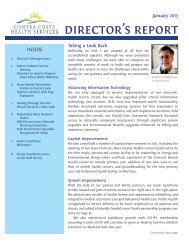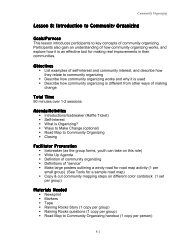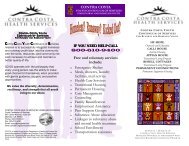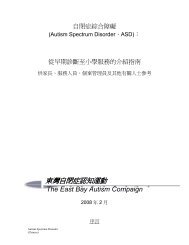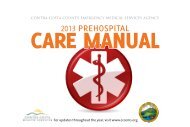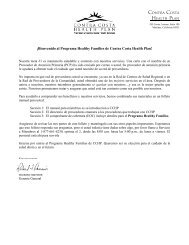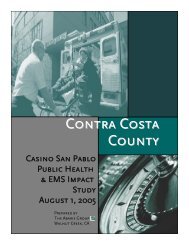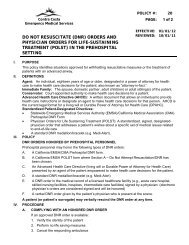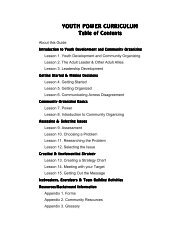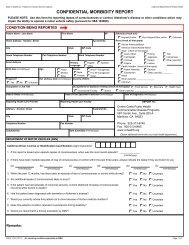EMS Policy Manual - Contra Costa Health Services
EMS Policy Manual - Contra Costa Health Services
EMS Policy Manual - Contra Costa Health Services
You also want an ePaper? Increase the reach of your titles
YUMPU automatically turns print PDFs into web optimized ePapers that Google loves.
<strong>Contra</strong> <strong>Costa</strong><br />
Emergency Medical <strong>Services</strong><br />
POLICY #: 13<br />
PAGE: 3 of 5<br />
IV. CALL-IN CRITERIA FOR BASE HOSPITAL DESTINATION DECISION<br />
A. Most trauma mechanisms are variable in terms of risk for significant injury. In order to maintain the<br />
highest accuracy in trauma triage, base hospital destination decision is required prior to transport of<br />
the following patients (who do not meet high-risk criteria otherwise):<br />
1. Evidence of high-energy dissipation or rapid deceleration, which may include:<br />
a. vehicle rollover with unrestrained occupant,<br />
b. intrusion of passenger space by one foot or greater,<br />
c. impact of 40 mph or greater (restrained),<br />
d. persons requiring disentanglement from a vehicle.<br />
2. Persons struck by vehicle with impact 20 mph or less.<br />
3. Persons ejected from a moving object (motorcycle, horse, etc.).<br />
4. Significant blunt force to the head. Symptoms may include:<br />
Loss of consciousness, repetitive questioning, abnormal or combative behavior, vomiting,<br />
headache, or new onset of confusion.<br />
5. Significant blunt force to the neck, thorax (chest/back), abdomen or pelvis.<br />
6. Penetrating injury to extremities (above knee or elbow) without apparent fracture.<br />
Base contact should be made if a patient meets call-in criteria and it is believed trauma center services<br />
may be needed, even in the event that the trauma has occurred several hours prior to Emergency<br />
Medical <strong>Services</strong> (<strong>EMS</strong>) response.<br />
B. Patients 60 years of age and older may sustain significant injuries with less forceful mechanisms,<br />
and may merit call-in for less significant mechanisms (e.g. ground level fall with new alteration of<br />
mental status).<br />
C. If no significant symptoms or physical findings noted despite above mechanism(s), call-in is not<br />
required and the patient may be transported to the patient’s hospital of choice or to the closest<br />
appropriate facility.<br />
D. Those patients who do not meet criteria for trauma center services shall be transported to the<br />
closest appropriate facility or the patient’s facility of choice.<br />
V. TRIAGE AND REPORTING PROCEDURES<br />
A. Determine whether the patient meets high-risk criteria for direct transport or meets call-in criteria.<br />
B. Contact the Base Hospital as soon as possible for either early notification or destination decision as<br />
indicated in the Trauma Triage Algorithm.<br />
1. Early Notification Report: This report should be brief (approximately one minute)<br />
a. Agency name and unit number<br />
b. Advise as Early Notification Report<br />
c. ETA at trauma center<br />
d. Patient age and sex<br />
e. Urgent concerns<br />
f. Brief description of mechanism of injury and scene<br />
g. Brief description of known significant abnormalities in primary and secondary surveys<br />
2. Destination Decision Report: This report needs to contain sufficient detail to aid in decision<br />
making by base physician.



